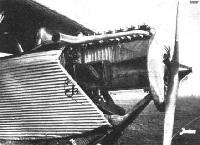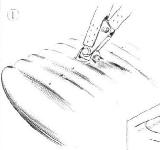
Junkers. Самолеты 1920-х годов
<...>
Первым послевоенным самолетом "Junkers" военного назначения стал двухместный разведчик H 21 с крылом схемы парасоль, оснащенный мотором BMW IIIa мощностью 185 л.с. Примерно 100 машин H 21 было построено на заводе "Junkers" в Филях, Москва. Все они поступили на вооружение ВВС РККА, первый - в 1924 году.
<...>
Описание:
- Junkers. Самолеты 1920-х годов
- Flight, August 1923
GOTHENBURG International Aero Exhibition 1923 - Flight, June 1924
THE THIRD INTERNATIONAL AERO SHOW AT PRAGUE - Flight, May 1925
THE ROUND-GERMANY FLIGHT
Фотографии
-
АвиаМастер 2006-05 / В.Котельников - Красные звезды Туркестана /Из истории воздушных войн/ (2)
"Юнкерс" Ю-21 из эскадрильи им. Свердлова, Ташкент, 1925г.
-
Aviation Historian 33 / V.Kotelnikov - The long road to Kabul
In late May 1929 five Soviet-built Junkers T 21s (aka “Ju 21s”) of the Soviet Air Force’s Termez-based 35th Air Detachment of the 454th Air Brigade may have taken part in a secret mission against insurgents in Tashqurgan, bearing no markings of any kind, as seen here. The T 21 was a two-seat reconnaissance parasol-wing monoplane, with a flexible gun-mounting fitted to the rear cockpit.
-
Air Enthusiast 2007-01 / L.Andersson - Doubly Clandestine /Between the wars/
The first J 21 was completed at Dessau in the summer of 1923 and flown for the first time on June 12.
-
АвиаМастер 2006-04 / В.Котельников - Красные звезды Туркестана /Из истории воздушных войн/ (1)
"Юнкерс" Ю-21 из эскадрильи им. Свердлова, построенный на средства, собранные крестьянами Тюменской губернии
-
Air Enthusiast 2007-01 / L.Andersson - Doubly Clandestine /Between the wars/
The J 21 was used by several of the Soviet Air Force's reconnaissance squadrons, including 'Krasnaya Moskva' (Red Moscow).
-
Авиация и Время 2009-01 / И.Бабенко - Германский мечтатель
Регистрационный номер: СССР-Ф15 Самолет-разведчик Ю-21, выпускаемый в СССР на концессионном предприятии Юнкерса в Филях
-
Air Enthusiast 2007-01 / L.Andersson - Doubly Clandestine /Between the wars/
The 100th aircraft completed at Fili was J 21 c/n 504, and the occasion warranted special celebrations.
-
АвиаМастер 2006-05 / В.Котельников - Красные звезды Туркестана /Из истории воздушных войн/ (2)
Летчики и техники возле "Юнкерса" Ю-21
-
Air Enthusiast 2007-01 / L.Andersson - Doubly Clandestine /Between the wars/
One of the J 21 prototypes in snowy surroundings, probably at Fili.
-
Air Enthusiast 2007-01 / L.Andersson - Doubly Clandestine /Between the wars/
Close-up of the skis designed for the J 21.
-
Air Enthusiast 2007-01 / L.Andersson - Doubly Clandestine /Between the wars/
J 21 c/n 358 before final assembly showing details of its design and how the armament was fitted.
-
Air Enthusiast 2000-11 / L.Andersson - Iranian Eagles
Only known photograph of the Junkers H.21 in Tehran - standing in front of the hangar to the left. The other two aircraft are F.13s.
Другие самолёты на фотографии: Junkers F 13 - Германия - 1919
-
Air Enthusiast 2007-01 / L.Andersson - Doubly Clandestine /Between the wars/
The single-seat J 22 fighter, first flown on November 17, 1923, was not accepted for production at Fili due to its poor performance.
-
Flight 1925-05 / Flight
The Junkers T.26 is an all-Duralumin parasol monoplane with Junkers engine.
-
Flight 1925-05 / Flight
The Junkers L.I air-cooled engine as installed in the Junkers T.26 aeroplane.
-
АвиаМастер 2006-04 / В.Котельников - Красные звезды Туркестана /Из истории воздушных войн/ (1)
Результаты неудачных посадок "юнкерсов" Ю-21 в Туркестане. Фотоснимки из "аварийных актов"
-
АвиаМастер 2006-05 / В.Котельников - Красные звезды Туркестана /Из истории воздушных войн/ (2)
Вынужденная посадка Ю-21 из 35-го отряда по причине отказа мотора при перелете в Чиназ, 15 апреля 1929г.
-
Авиация и Космонавтика 2020-11 / В.Котельников - Советские летчики и самолеты в Афганистане
Авария разведчика Ю-21 в Термезе 29 мая 1929 г. Летчик П. Борзин не справился с управлением при посадке в сильный ветер. Возможно, что этот самолет участвовал в поддержке операций группы Примакова на севере Афганистана
-
Flight 1923-08 / Flight
JUNKERS AT GOTHENBURG: (Junkers T 19) 1 is a perspective view of the small school machine, type T, which is fitted with a six-cylinder vertical air-cooled Junkers engine. 2 details of the undercarriage. 3 the fan which is used for cooling the air-cooled engine. 4 access to the cockpit of the type T is gained through a triangular door. 5 a typical strut assembly.
-
Flight 1924-06 / Flight
SOME GERMAN CONSTRUCTIONAL DETAILS AT PRAGUE: 1. The strut-attachment on the lower plane of the Junkers type "U."
-
Flight 1924-06 / Flight
SOME GERMAN CONSTRUCTIONAL DETAILS AT PRAGUE: 2. Attachment of lower plane to fuselage on the same machine.
- Фотографии





















